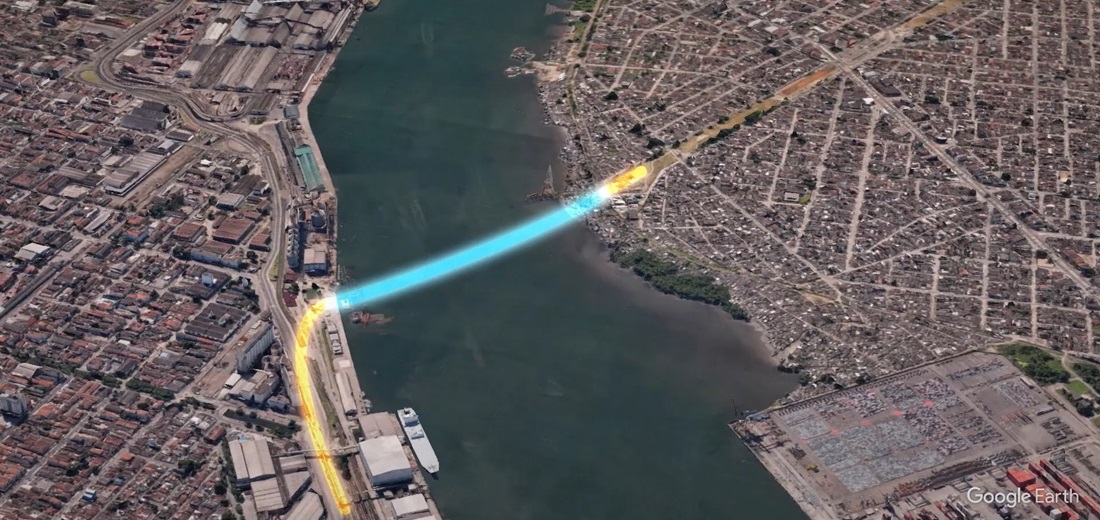
Proposed fare for Santos-Guarujá Tunnel set at BRL 6.15
Mar, 22, 2024 Posted by Gabriel MalheirosWeek 202412
The toll rate for the Santos-Guarujá immersed tunnel will be equivalent to that of the Santos-Guarujá ferry crossing. The suggested base fare is R$ 6.15, totaling R$ 12.30 for a round trip (set in March 2023 and subject to inflationary correction). The toll fee will operate on a free-flow system, with unrestricted passage and automatic electronic billing, as outlined in the project’s draft tender. The concession contract holder will be responsible for implementing the toll plaza-free system.
The base fare applies to cars, pickups, tricycles, and vans. Other vehicles will have a multiplier factor according to the contract.
Motorcycles, scooters, and motorized bicycles will have the cheapest rates, paying half of the base fare. The base fare for trucks with trailers, tractor-trailer trucks, and double-axle semi-trailers with six axles will be multiplied by six, bringing the total to R$ 36.90.
Contributions
The tunnel will be tendered as a public-private partnership (PPP). The project’s draft is available on the website of the São Paulo State Transportation Agency (Artesp) under the “Transparency” menu, along with all project-related documents.
It’s worth noting that the tender is still being prepared, as the project is in the public consultation phase, with contributions accepted until May 3 via the Internet.
The Santos-Guarujá tunnel is the main project under the Federal Government’s Growth Acceleration Program (PAC), with an estimated investment of R$ 5.96 billion. The project will be carried out in partnership with the State Government, with each party covering 50% of the projected cost, following an agreement between Governor Tarcísio de Freitas and President Luiz Inácio Lula da Silva.
The Project
The underwater tunnel will be 860 meters long, connecting both sides of the port between Santos and Guarujá, allowing cars to cross from one end to the other in one minute and thirty seconds.
As stated by the President of the Santos Port Authority (APS), Anderson Pomini, to A Tribuna in February, “the layout remains the same (as the original project developed by Dersa), with subtle modifications at both entrances, to accommodate the Navy Wharf, and at the exit, in Prainha, which will connect to the Cônego Domenico Rangoni Highway and, in turn, to Guarujá Airport. On the Santos side, an area near the port headquarters will be expropriated.”
Work Stages
Pomini explained that the tunnel construction encompasses three phases. The first stage involves setting up the construction site on the Left Bank, on the Guarujá side, below the power line, where the three precast panels will be built, serving as the tunnel’s walls. The second phase includes dredging, and the third and final phase involves the sinking and securing of the panels, i.e., the implementation of the tunnel under the sea. It’s the same immersion technique being used to connect Denmark to Germany.
The APS President added that “currently, the draught is 15 meters, which could reach 17 meters; the tunnel’s ceiling will be 21 meters deep, measured from the waterline.”
PPP
The legal and economic modeling of the public-private partnership (PPP) will be developed by the Vanzolini Foundation, whose hiring was announced by APS on December 21.
Pomini confirmed that there would be no delays in the already defined schedule for launching the tender in the second half of this year, with the concession starting and consequently, the works in 2025.
Source: A Tribuna
Click here to read the original news text: https://www.atribuna.com.br/noticias/portomar/tunel-santos-guaruja-tem-tarifa-sugerida-de-r-615
-
Ports and Terminals
Jun, 19, 2023
0
Port of Santos to offer up to 65% discounts based on number of calls
-
Meat
Sep, 17, 2019
0
African swine flu hits South Korea and Japan
-
Mar, 08, 2023
0
MOL to install Norsepower’s rotor sails on a bulker chartered by VALE
-
Meat
Jun, 03, 2020
0
Vietnam authorizes four Brazilian slaughterhouses for meat exports


